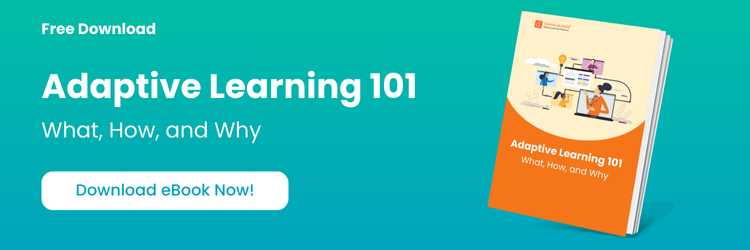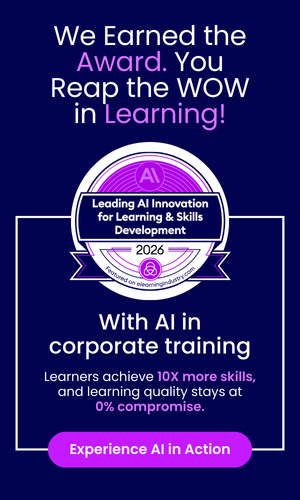Learners scroll past dated courses, admins wrestle with clunky reports, and completion rates refuse to budge. Sound familiar? Traditional Learning Management Systems (LMSs) simply weren’t built for always-on, data-driven workplaces. What if your platform could predict skills gaps, curate micro-content in seconds, and refine each learner’s path on the fly? That promise belongs to the AI-first learning platform—and it’s already displacing the LMS status quo. Ready to see how (and why) to make the leap?
→ Download eBook: Adaptive Learning 101
Table Of Contents
- Why the Classic LMS Has Hit Its Ceiling
- Inside an AI-First Learning Platform
- LMS vs LXP vs AI-First: Key Differences
- Building Your Migration Roadmap
- Barriers to Adoption—and How to Bust Them
Why the Classic LMS Has Hit Its Ceiling
Global Learning Management System (LMS) spend keeps rising—USD 24 billion in 2024 and heading for USD 28.6 billion this year—but buyer frustration rises with it. Analyst polls list three persistent pain points:
1. Low engagement
users abandon long, one-size modules, triggering poor ROI
2. Siloed data
SCORM-centric tracking can’t surface skills gaps or serve real-time recommendations
3. Complex integrations
HRIS, CRM, and performance tools connect via brittle workarounds
Result? LMSs become compliance tick-boxes rather than growth engines.
Inside an AI-First Learning Platform
What Makes an AI-First Learning Platform Stand Out?
With an adaptive learning engine, it personalizes learning experiences, while generative content curation ensures relevant and engaging material. Predictive skill analytics identify growth areas, and autonomous learning paths empower learners to progress at their own pace.
AI-first platforms flip the script by embedding machine learning from the ground up. Look for four signature capabilities:
1. Adaptive learning engine
Algorithms analyze click-stream, assessment, and xAPI events to personalize sequence, pace, and modality

2. Generative content curation
Large-language models auto-summarize PDFs and craft micro-videos, shrinking production cycles from weeks to hours
Discover the secrets to designing microlearning videos that captivate your audience and boost knowledge retention!
3. Predictive skill analytics
Continuous data feeds spot emerging gaps before they hurt performance; dashboards forecast reskilling needs
4. Autonomous learning paths
Agentic AI nudge, remediate, and even author practice quizzes without admin intervention

Adaptive Learning 101
Explore the What, the Why, and the How!
- Introduction to Adaptive Learning
- Levels of Adaptive Learning
- Examples
- Case Studies
Investor confidence is rising: the adaptive learning market itself is set to jump 52.7% year-over-year, from $2.87 B in 2024 to $4.39 B in 2025 (TBRC, 2025). Workera, an AI skills-intelligence platform for enterprises, even secured a strategic investment from Accenture in January 2025.
LMS vs LXP vs AI-First: Key Differences
|
Capability |
Classic LMS |
LXP |
AI-First Platform |
|
Primary goal |
Deliver and track courses |
Curate discovery feed |
Predict and personalize learning |
|
Data spec |
SCORM, AICC |
xAPI add-ons |
xAPI + real-time telemetry |
|
Content model |
Linear modules |
Links and playlists |
Dynamic, AI-generated objects |
|
Intelligence layer |
Rules and reports |
Tags and recommendations |
Deep-learning models and agents |
|
Upgrade cycle |
Major annual releases |
Quarterly |
Continuous (cloud, MLOps) |
Building Your Migration Roadmap
1. Audit use-cases, not just courses
Map compliance, onboarding, and role-based upskilling to decide which flows demand AI adaptivity.
2. Harvest xAPI data early
Pull records into a Learning Record Store so algorithms have historic signals to train on.
3. Run a pilot cohort
Limit scope (e.g., new-hire sales bootcamp) and benchmark engagement lift vs current LMS baseline.
4. Stage integrations
Prioritize SSO, HRIS feeds, and communication platforms (Teams, Slack) to enable in-flow nudges.
5. Upskill your team
Data literacy and prompt-engineering workshops should precede full rollout (adaptive learning market CAGR 52.7% proves urgency).
Barriers to Adoption—and How to Bust Them
1. Data privacy jitters
Choose vendors with on-prem or single-tenant hosting, plus SOC 2 reports.
2. Change fatigue
Anchor messaging on learner benefits (‘Netflix-style paths’) and manager dashboards.
3. Skill gaps in L&D
Pair IDs with data scientists; automate low-value tasks so IDs focus on experience design.
4. Legacy contract lock-ins
Negotiate co-existence: pipe LMS completions into the AI platform, then sunset modules as renewal dates arrive.
Forward-looking analysts predict AI-powered personalization and in-flow nudges will dominate 2025 learning tech budgets. Get ahead now, and you’ll transform L&D from course factory to strategic performance partner.
Wrapping Up
AI-first learning platforms are no longer a ‘nice-to-have’ experiment—they’re fast becoming the operating system of modern L&D. By unifying adaptive engines, generative content, and predictive skill analytics, they transform an LMS from a compliance repository into a living talent accelerator. If you want learning to keep pace with business change, now is the moment to plot your migration.
Need a practical blueprint? ‘Adaptive Learning 101: A Guide for L&D Professionals’ distils frameworks, checklists, and success stories to help you roll out personalization at scale. Download your free copy and take the first step towards an AI-fueled future of learning.




![The Role of Learning Analytics in eLearning Assessments [Infographic]](https://www.commlabindia.com/hubfs/Imported_Blog_Media/learning-analytics-elearning-assessments.jpg)

